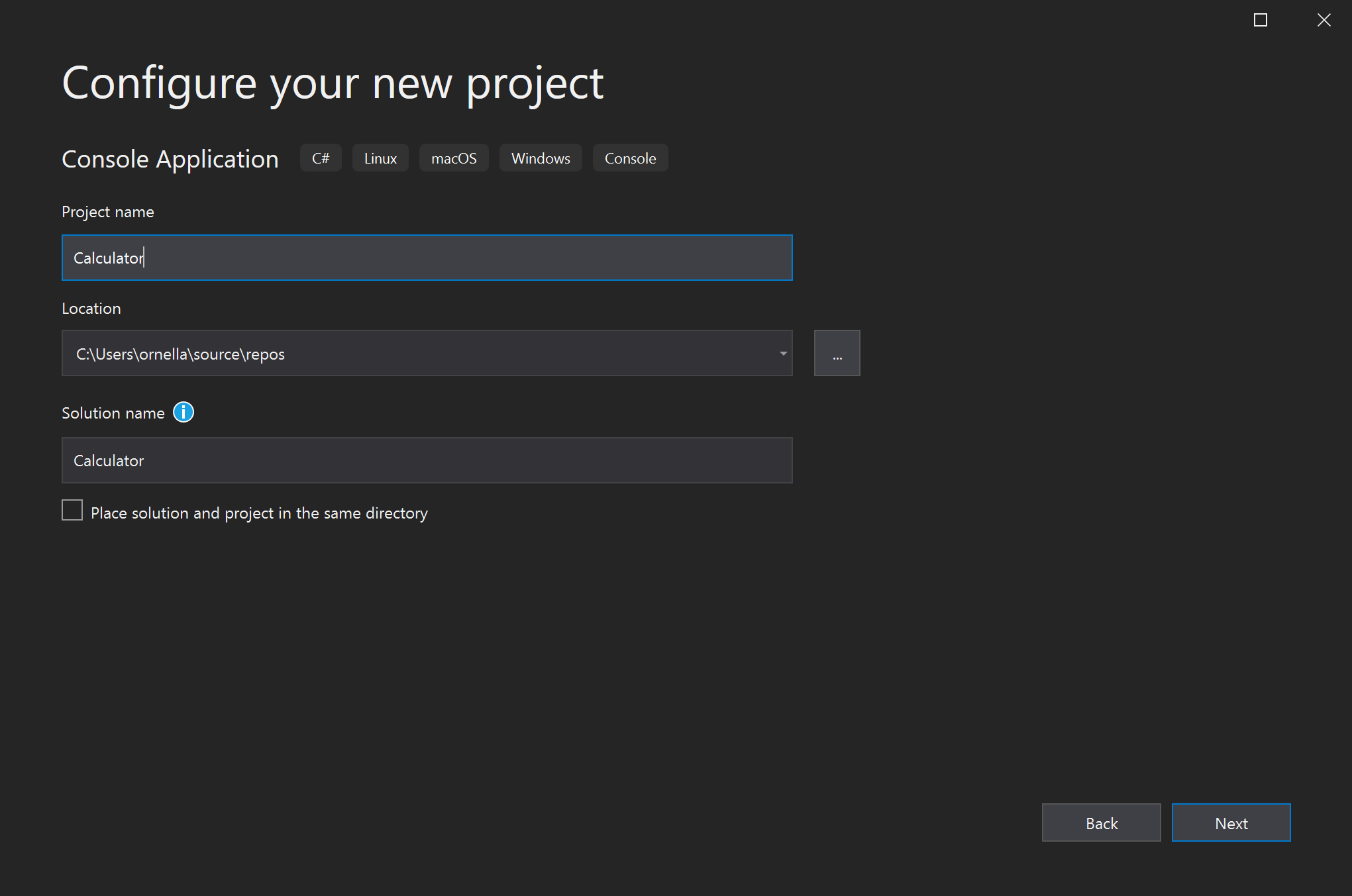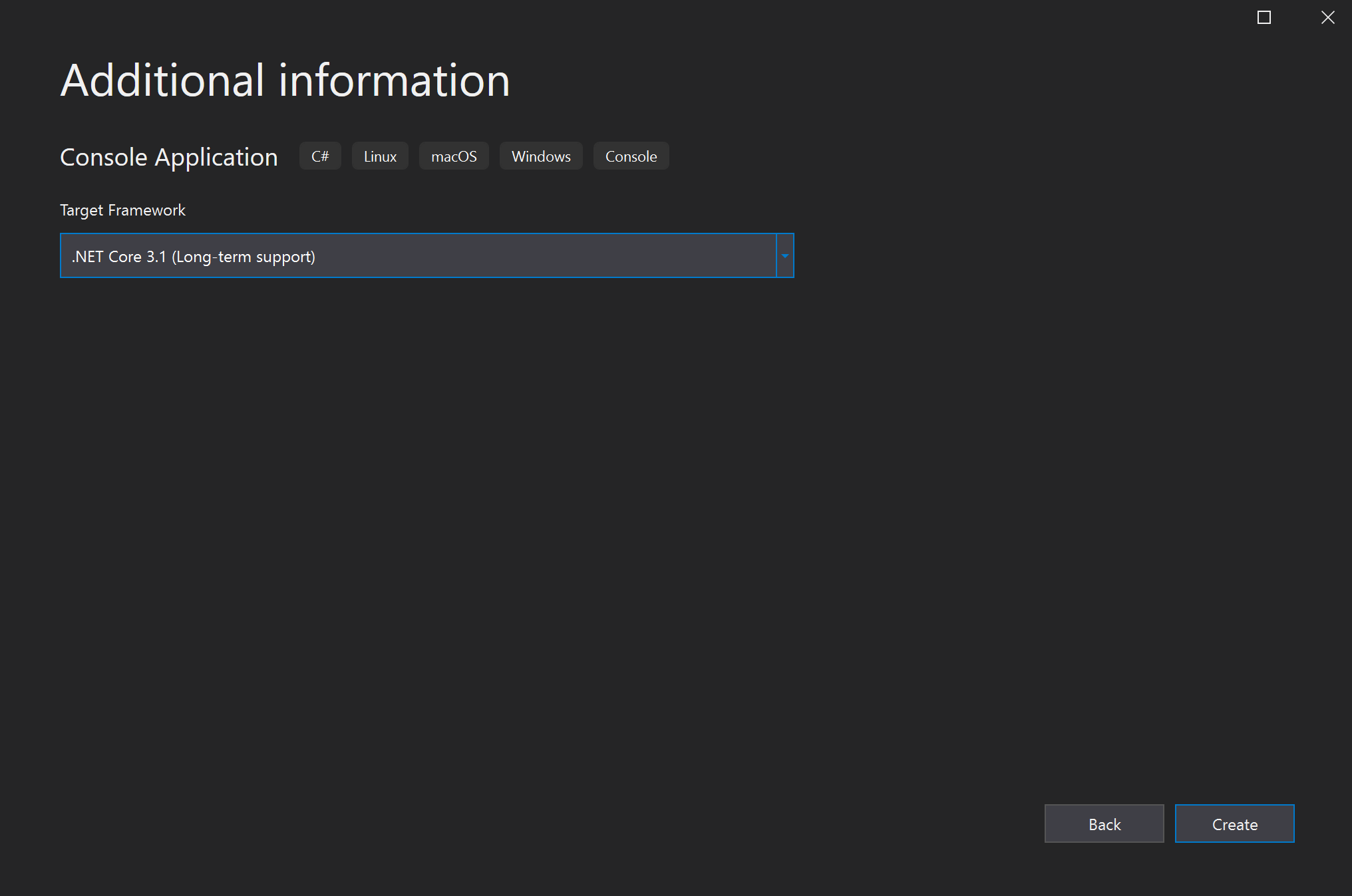Tutorial: Create a simple C# console app in Visual Studio (part 1 of 2)
In this tutorial, you use Visual Studio to create and run a C# console app, and explore some features of the Visual Studio integrated development environment (IDE). This tutorial is part 1 of a two-part tutorial series.
In this tutorial, you complete the following tasks:
- Create a Visual Studio project.
- Create a C# console app.
- Debug your app.
- Close your app.
- Inspect your complete code.
In part 2, you extend this app to add more projects, learn debugging tricks, and reference third-party packages.
Prerequisites
You must have Visual Studio installed.
If you haven't already installed Visual Studio, go to the Visual Studio downloads page to install it for free.
Create a project
To start, create a C# application project. The project type comes with all the template files you need.
Open Visual Studio, and select Create a new project in the Start window.

In the Create a new project window, choose C# from the Language list. Next, choose Windows from the Platform list and Console from the project types list.
After you apply the language, platform, and project type filters, choose the Console Application template, and then select Next.
Note
If you don't see the Console Application template, select Install more tools and features.

In the Visual Studio Installer, select the .NET Core cross-platform development workload.

Select Modify in the Visual Studio Installer. You might be prompted to save your work. Select Continue to install the workload.
Return to step 2 in this "Create a project" procedure.
In the Configure your new project window, type or enter Calculator in the Project name box. Then, select Next.
In the Additional information window, verify that .NET Core 3.1 appears in the Target Framework field. Then, select Create.
Visual Studio opens your new project, which includes default "Hello World" code. To view it in the editor, select the code file Program.cs in the Solution Explorer window, which is typically on the right-hand side of Visual Studio.
The default "Hello World" code calls the WriteLine method to display the literal string "Hello, World!" in the console window. If you press F5, you can run the default program in Debug mode. After the application runs in the debugger, the console window stays open. Press any key to close the console window.
Open Visual Studio, and select Create a new project in the Start window.
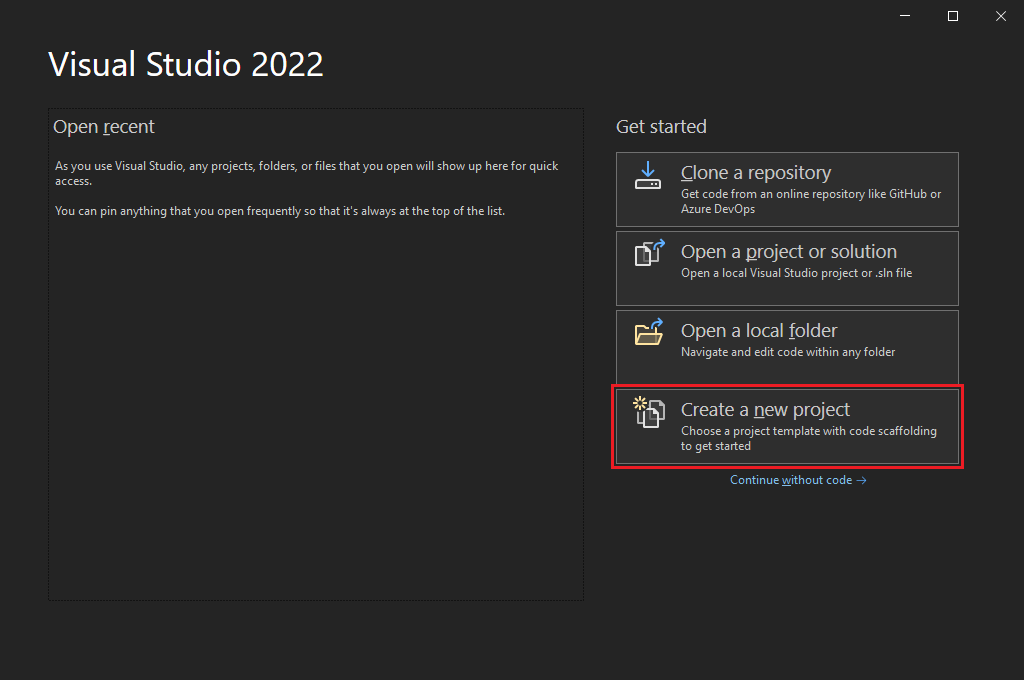
In the Create a new project window, select All languages, and then choose C# from the dropdown list. Choose Windows from the All platforms list, and choose Console from the All project types list.
After you apply the language, platform, and project type filters, choose the Console App template, and then select Next.
Note
If you don't see the Console App template, select Install more tools and features.

In the Visual Studio Installer, select the .NET desktop development workload.

Select Modify in the Visual Studio Installer. You might be prompted to save your work. Select Continue to install the workload.
Return to step 2 in this "Create a project" procedure.
In the Configure your new project window, type or enter Calculator in the Project name box, and then select Next.
In the Additional information window, select .NET 8.0 for the Target Framework field. Then, select Create.
Visual Studio opens your new project, which includes default "Hello World" code. To view it in the editor, select the code file Program.cs in the Solution Explorer window, which is typically on the right-hand side of Visual Studio.
The single code statement calls the WriteLine method to display the literal string "Hello, World!" in the console window. If you press F5, you can run the default program in Debug mode. After the application runs in the debugger, the console window stays open. Press any key to close the console window.
Note
Starting with .NET 6, new projects using the console template generate different code than previous versions. To learn more, see the New C# templates generate top-level statements page.
Create the app
In this section, you complete the following tasks:
- Explore some basic integer math in C#.
- Add code to create a basic calculator app.
- Debug the app to find and fix errors.
- Refine the code to make it more efficient.
Explore integer math
Start with some basic integer math in C#.
In the code editor, delete the default "Hello World" code.
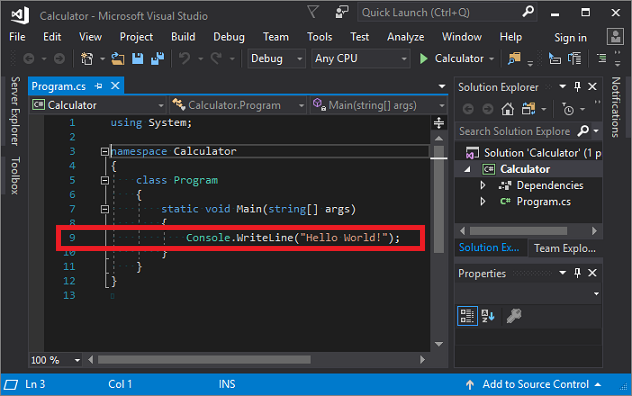
Specifically, delete the line that says,
Console.WriteLine("Hello World!");.In its place, enter the following code:
int a = 42; int b = 119; int c = a + b; Console.WriteLine(c); Console.ReadKey();Notice that when you enter the code, the IntelliSense feature in Visual Studio offers you the option to autocomplete the entry.
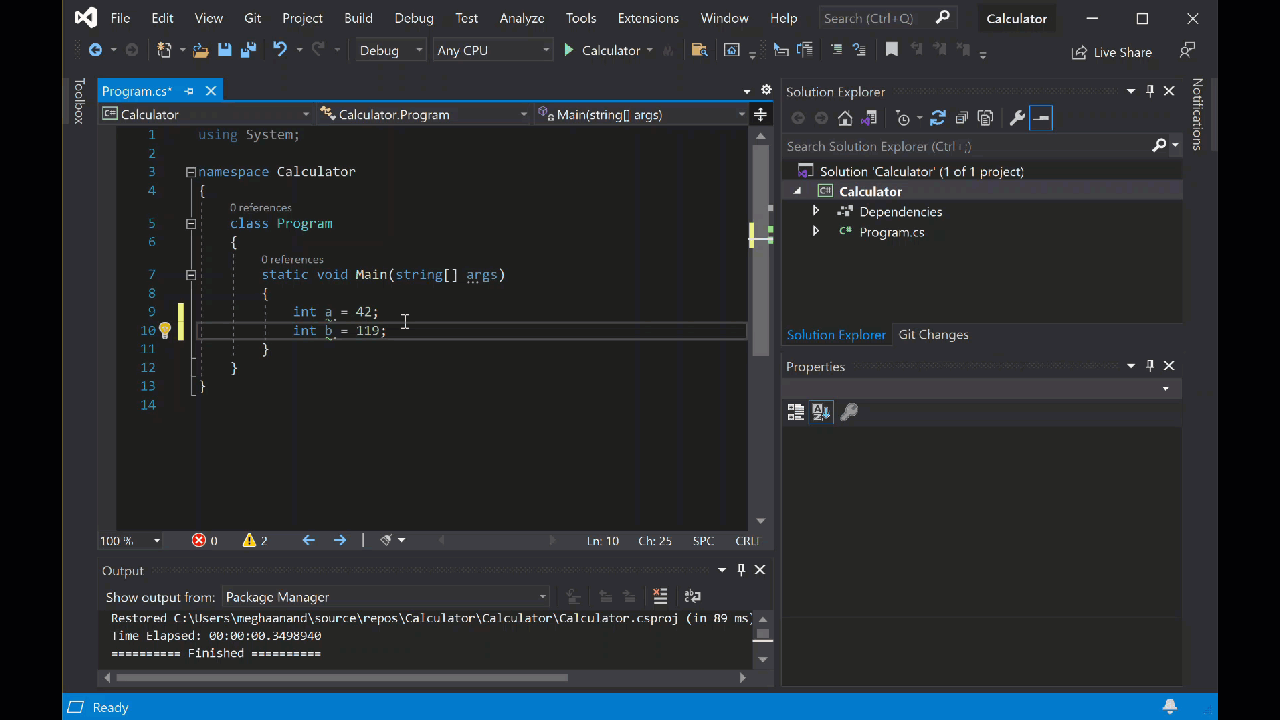
Select the green Start button next to Calculator to build and run your program, or press F5.

A console window opens that reveals the sum of 42 + 119, which is 161.
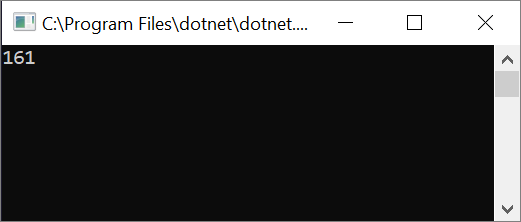
(Optional) You can change the operator to change the result. For example, you can change the
+operator in theint c = a + b;line of code to-for subtraction,*for multiplication, or/for division. Then, when you run the program, the result changes, too.Close the console window.
In Solution Explorer, in the right pane, select Program.cs to display the file in the code editor
In the code editor, replace the default "Hello World" code that says
Console.WriteLine("Hello World!");.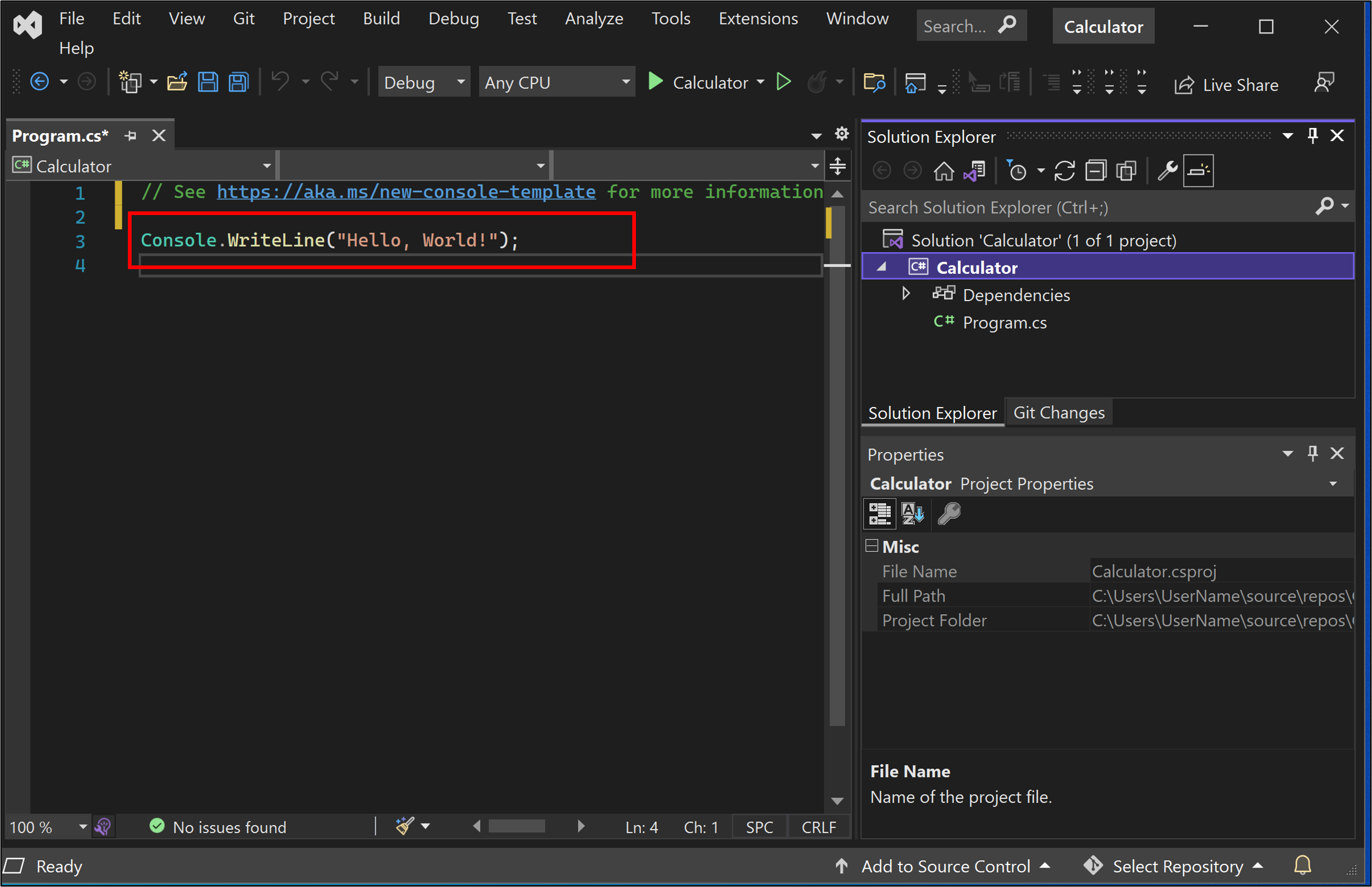
Replace the line with the following code:
int a = 42; int b = 119; int c = a + b; Console.WriteLine(c); Console.ReadKey();If you enter the code, the Visual Studio IntelliSense feature offers you the option to autocomplete the entry.

To build and run your app, press F5, or select the green arrow next to the name Calculator in the top toolbar.

A console window opens that shows the sum of 42 + 119, which is 161.

Close the console window.
Optionally, you can change the operator to change the result. For example, you can change the
+operator in theint c = a + b;line of code to-for subtraction,*for multiplication, or/for division. When you run the app, the result changes accordingly.
Add code to create a calculator
Continue by adding a more complex set of calculator code to your project.
In the code editor, replace all the code in Program.cs with the following new code:
using System; namespace Calculator { class Program { static void Main(string[] args) { // Declare variables and then initialize to zero. int num1 = 0; int num2 = 0; // Display title as the C# console calculator app. Console.WriteLine("Console Calculator in C#\r"); Console.WriteLine("------------------------\n"); // Ask the user to type the first number. Console.WriteLine("Type a number, and then press Enter"); num1 = Convert.ToInt32(Console.ReadLine()); // Ask the user to type the second number. Console.WriteLine("Type another number, and then press Enter"); num2 = Convert.ToInt32(Console.ReadLine()); // Ask the user to choose an option. Console.WriteLine("Choose an option from the following list:"); Console.WriteLine("\ta - Add"); Console.WriteLine("\ts - Subtract"); Console.WriteLine("\tm - Multiply"); Console.WriteLine("\td - Divide"); Console.Write("Your option? "); // Use a switch statement to do the math. switch (Console.ReadLine()) { case "a": Console.WriteLine($"Your result: {num1} + {num2} = " + (num1 + num2)); break; case "s": Console.WriteLine($"Your result: {num1} - {num2} = " + (num1 - num2)); break; case "m": Console.WriteLine($"Your result: {num1} * {num2} = " + (num1 * num2)); break; case "d": Console.WriteLine($"Your result: {num1} / {num2} = " + (num1 / num2)); break; } // Wait for the user to respond before closing. Console.Write("Press any key to close the Calculator console app..."); Console.ReadKey(); } } }Select the Calculator button or press F5 to run your app.
A console window opens.
In the console window, follow the prompts to add the numbers 42 and 119 together.
Your app should look similar to the following screenshot:
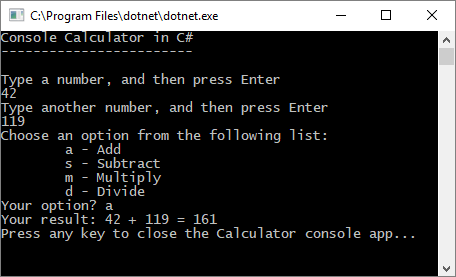
In the code editor, replace all the code in Program.cs with the following new code:
// Declare variables and then initialize to zero. int num1 = 0; int num2 = 0; // Display title as the C# console calculator app. Console.WriteLine("Console Calculator in C#\r"); Console.WriteLine("------------------------\n"); // Ask the user to type the first number. Console.WriteLine("Type a number, and then press Enter"); num1 = Convert.ToInt32(Console.ReadLine()); // Ask the user to type the second number. Console.WriteLine("Type another number, and then press Enter"); num2 = Convert.ToInt32(Console.ReadLine()); // Ask the user to choose an option. Console.WriteLine("Choose an option from the following list:"); Console.WriteLine("\ta - Add"); Console.WriteLine("\ts - Subtract"); Console.WriteLine("\tm - Multiply"); Console.WriteLine("\td - Divide"); Console.Write("Your option? "); // Use a switch statement to do the math. switch (Console.ReadLine()) { case "a": Console.WriteLine($"Your result: {num1} + {num2} = " + (num1 + num2)); break; case "s": Console.WriteLine($"Your result: {num1} - {num2} = " + (num1 - num2)); break; case "m": Console.WriteLine($"Your result: {num1} * {num2} = " + (num1 * num2)); break; case "d": Console.WriteLine($"Your result: {num1} / {num2} = " + (num1 / num2)); break; } // Wait for the user to respond before closing. Console.Write("Press any key to close the Calculator console app..."); Console.ReadKey();Select the Calculator button or press F5 to run your app.
A console window opens.
In the console window, follow the prompts to add the numbers 42 and 119 together.
Your app should look similar to the following screenshot:

Add decimal functionality
Now, tweak the code to add more functionality.
The current calculator app only accepts and returns whole numbers. For example, if you run the app and divide the number 42 by the number 119, your result is zero, which isn't exact.

To fix the code to improve precision by handling decimals:
From Program.cs in the Visual Studio editor, press Ctrl+H to open the Find and Replace control.
Type int in the control, and type float in the Replace field.
Select the icons for Match case and Match whole word in the control, or press Alt+C and Alt+W.
Select the Replace all icon or press Alt+A to run the search and replace.
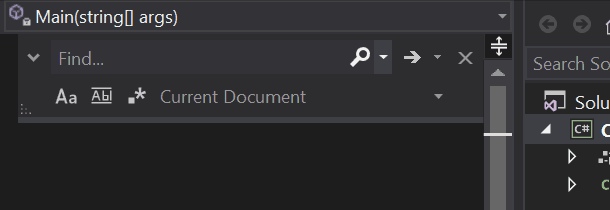
Run your calculator app again, and divide the number 42 by the number 119.
The app now returns a decimal number instead of zero.
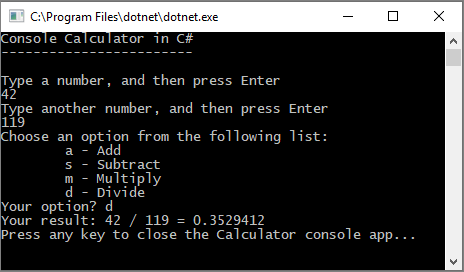
Now the app can produce decimal results. Make a few more tweaks to the code so the app can calculate decimals too.
Use the Find and Replace control to change each instance of the
floatvariable todouble, and to change each instance of theConvert.ToInt32method toConvert.ToDouble.Run your calculator app, and divide the number 42.5 by the number 119.75.
The app now accepts decimal values, and returns a longer decimal numeral as its result.

In the Revise the code section, you reduce the number of decimal places in the results.
Debug the app
You improved your basic calculator app, but your app doesn't yet handle exceptions, such as user input errors. For example, if users try to divide by zero, or enter an unexpected character, the app might stop working, return an error, or return an unexpected non-numeric result.
Let's walk through a few common user input errors, locate them in the debugger if they appear there, and fix them in the code.
Tip
For more information about the debugger and how it works, see First look at the Visual Studio debugger.
Fix the "divide by zero" error
If you try to divide a number by zero, the console app might freeze, and then shows you what's wrong in the code editor.
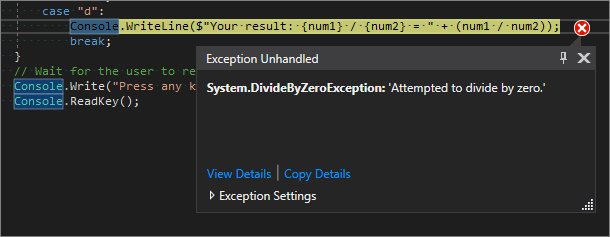
Note
Sometimes the app doesn't freeze, and the debugger doesn't show a divide-by-zero error. Instead, the app might return an unexpected nonnumeric result, such as an infinity symbol. The following code fix still applies.
Let's change the code to handle this error. In Program.cs, replace the code for case "d": with the following code:
// Ask the user to enter a non-zero divisor until they do so.
while (num2 == 0)
{
Console.WriteLine("Enter a non-zero divisor: ");
num2 = Convert.ToInt32(Console.ReadLine());
}
Console.WriteLine($"Your result: {num1} / {num2} = " + (num1 / num2));
break;
}
After you replace the code, the section with the switch statement should look similar to the following screenshot:
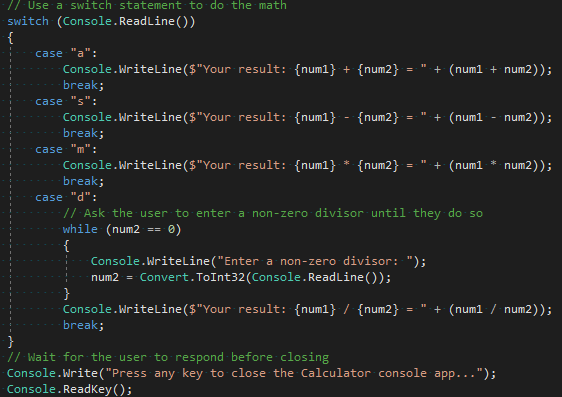
Now, when you divide any number by zero, the app asks for another number, and keeps asking until you provide a nonzero number.
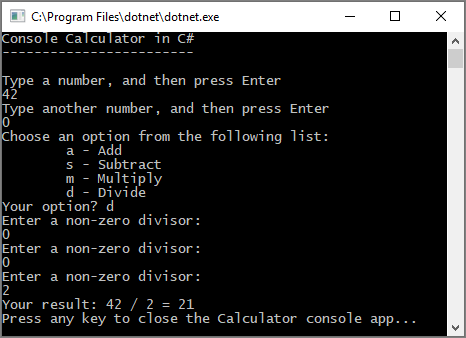
Fix the "format" error
If you enter an alphabetic character when the app expects a numeric character, the app freezes. Visual Studio shows you what's wrong in the code editor.

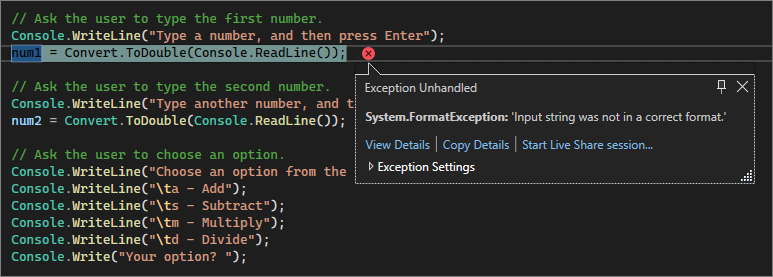
To prevent this exception, you can refactor the code you've previously entered.
Revise the code
Rather than rely on the program class to handle all the code, you can divide your app into two classes: Calculator and Program.
The Calculator class handles the bulk of the calculation work, and the Program class handles the user interface and error-handling work.
Let's get started.
In Program.cs, delete everything and add the following new
Calculatorclass:class Calculator { public static double DoOperation(double num1, double num2, string op) { double result = double.NaN; // Default value is "not-a-number" if an operation, such as division, could result in an error. // Use a switch statement to do the math. switch (op) { case "a": result = num1 + num2; break; case "s": result = num1 - num2; break; case "m": result = num1 * num2; break; case "d": // Ask the user to enter a non-zero divisor. if (num2 != 0) { result = num1 / num2; } break; // Return text for an incorrect option entry. default: break; } return result; } }Also add a new
Programclass, as follows:class Program { static void Main(string[] args) { bool endApp = false; // Display title as the C# console calculator app. Console.WriteLine("Console Calculator in C#\r"); Console.WriteLine("------------------------\n"); while (!endApp) { // Declare variables and set to empty. string numInput1 = ""; string numInput2 = ""; double result = 0; // Ask the user to type the first number. Console.Write("Type a number, and then press Enter: "); numInput1 = Console.ReadLine(); double cleanNum1 = 0; while (!double.TryParse(numInput1, out cleanNum1)) { Console.Write("This is not valid input. Please enter a numeric value: "); numInput1 = Console.ReadLine(); } // Ask the user to type the second number. Console.Write("Type another number, and then press Enter: "); numInput2 = Console.ReadLine(); double cleanNum2 = 0; while (!double.TryParse(numInput2, out cleanNum2)) { Console.Write("This is not valid input. Please enter a numeric value: "); numInput2 = Console.ReadLine(); } // Ask the user to choose an operator. Console.WriteLine("Choose an operator from the following list:"); Console.WriteLine("\ta - Add"); Console.WriteLine("\ts - Subtract"); Console.WriteLine("\tm - Multiply"); Console.WriteLine("\td - Divide"); Console.Write("Your option? "); string op = Console.ReadLine(); try { result = Calculator.DoOperation(cleanNum1, cleanNum2, op); if (double.IsNaN(result)) { Console.WriteLine("This operation will result in a mathematical error.\n"); } else Console.WriteLine("Your result: {0:0.##}\n", result); } catch (Exception e) { Console.WriteLine("Oh no! An exception occurred trying to do the math.\n - Details: " + e.Message); } Console.WriteLine("------------------------\n"); // Wait for the user to respond before closing. Console.Write("Press 'n' and Enter to close the app, or press any other key and Enter to continue: "); if (Console.ReadLine() == "n") endApp = true; Console.WriteLine("\n"); // Friendly linespacing. } return; } }Select the Calculator button or press F5 to run your app.
Follow the prompts and divide the number 42 by the number 119. Your results should look similar to the following screenshot:
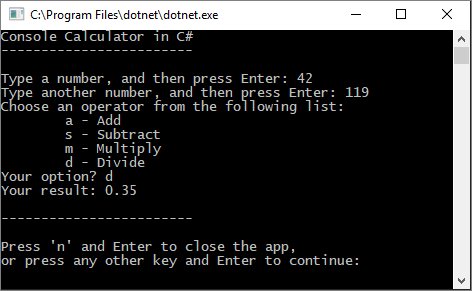
You can now run more calculations until you choose to close the console app. There are also fewer decimal places in the results. And if you enter an incorrect character, you get an appropriate error response.
Revise the code
Rather than rely on the program class to handle all the code, you can divide your app into two classes: Calculator and Program.
The Calculator class handles the bulk of the calculation work, and the Program class handles the user interface and error-handling work.
Let's get started.
In Program.cs, delete everything and add the following new
Calculatorclass:class Calculator { public static double DoOperation(double num1, double num2, string op) { double result = double.NaN; // Default value is "not-a-number" if an operation, such as division, could result in an error. // Use a switch statement to do the math. switch (op) { case "a": result = num1 + num2; break; case "s": result = num1 - num2; break; case "m": result = num1 * num2; break; case "d": // Ask the user to enter a non-zero divisor. if (num2 != 0) { result = num1 / num2; } break; // Return text for an incorrect option entry. default: break; } return result; } }Also add a new
Programclass, as follows:class Program { static void Main(string[] args) { bool endApp = false; // Display title as the C# console calculator app. Console.WriteLine("Console Calculator in C#\r"); Console.WriteLine("------------------------\n"); while (!endApp) { // Declare variables and set to empty. // Use Nullable types (with ?) to match type of System.Console.ReadLine string? numInput1 = ""; string? numInput2 = ""; double result = 0; // Ask the user to type the first number. Console.Write("Type a number, and then press Enter: "); numInput1 = Console.ReadLine(); double cleanNum1 = 0; while (!double.TryParse(numInput1, out cleanNum1)) { Console.Write("This is not valid input. Please enter a numeric value: "); numInput1 = Console.ReadLine(); } // Ask the user to type the second number. Console.Write("Type another number, and then press Enter: "); numInput2 = Console.ReadLine(); double cleanNum2 = 0; while (!double.TryParse(numInput2, out cleanNum2)) { Console.Write("This is not valid input. Please enter a numeric value: "); numInput2 = Console.ReadLine(); } // Ask the user to choose an operator. Console.WriteLine("Choose an operator from the following list:"); Console.WriteLine("\ta - Add"); Console.WriteLine("\ts - Subtract"); Console.WriteLine("\tm - Multiply"); Console.WriteLine("\td - Divide"); Console.Write("Your option? "); string? op = Console.ReadLine(); // Validate input is not null, and matches the pattern if (op == null || ! Regex.IsMatch(op, "[a|s|m|d]")) { Console.WriteLine("Error: Unrecognized input."); } else { try { result = calculator.DoOperation(cleanNum1, cleanNum2, op); if (double.IsNaN(result)) { Console.WriteLine("This operation will result in a mathematical error.\n"); } else Console.WriteLine("Your result: {0:0.##}\n", result); } catch (Exception e) { Console.WriteLine("Oh no! An exception occurred trying to do the math.\n - Details: " + e.Message); } } Console.WriteLine("------------------------\n"); // Wait for the user to respond before closing. Console.Write("Press 'n' and Enter to close the app, or press any other key and Enter to continue: "); if (Console.ReadLine() == "n") endApp = true; Console.WriteLine("\n"); // Friendly linespacing. } return; } }Note
It's best to use nullable types (with the
?symbol) for the input strings, sinceSystem.Console.ReadLinereturns a nullable reference type.Select the Calculator button or press F5 to run your app.
Follow the prompts and divide the number 42 by the number 119. Your results should look similar to the following screenshot:

You can now run more calculations until you choose to close the console app. There are also fewer decimal places in the results. And if you enter an incorrect character, you get an appropriate error response.
Close the app
If you haven't already done so, close the Calculator app.
Close the Output pane in Visual Studio.
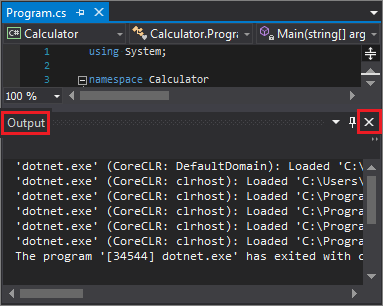
In Visual Studio, press Ctrl+S to save your app.
Add Git source control
Now that you have an application, you might want to add it to a Git repository. Visual Studio makes that process easy with Git tools you can use directly from the IDE.
Tip
Git is the most widely used modern version control system. Whether you're a professional developer or you're learning how to code, Git can be very useful. If you're new to Git, the https://git-scm.com/ website is a good place to start. You can find cheat sheets, a popular online book, and Git Basics videos.
To associate your code with Git, start by creating a new Git repository where your code is located:
In the status bar at the bottom-right of Visual Studio, select Add to Source Control, and then select Git.

In the Create a Git repository dialog box, sign in to GitHub:
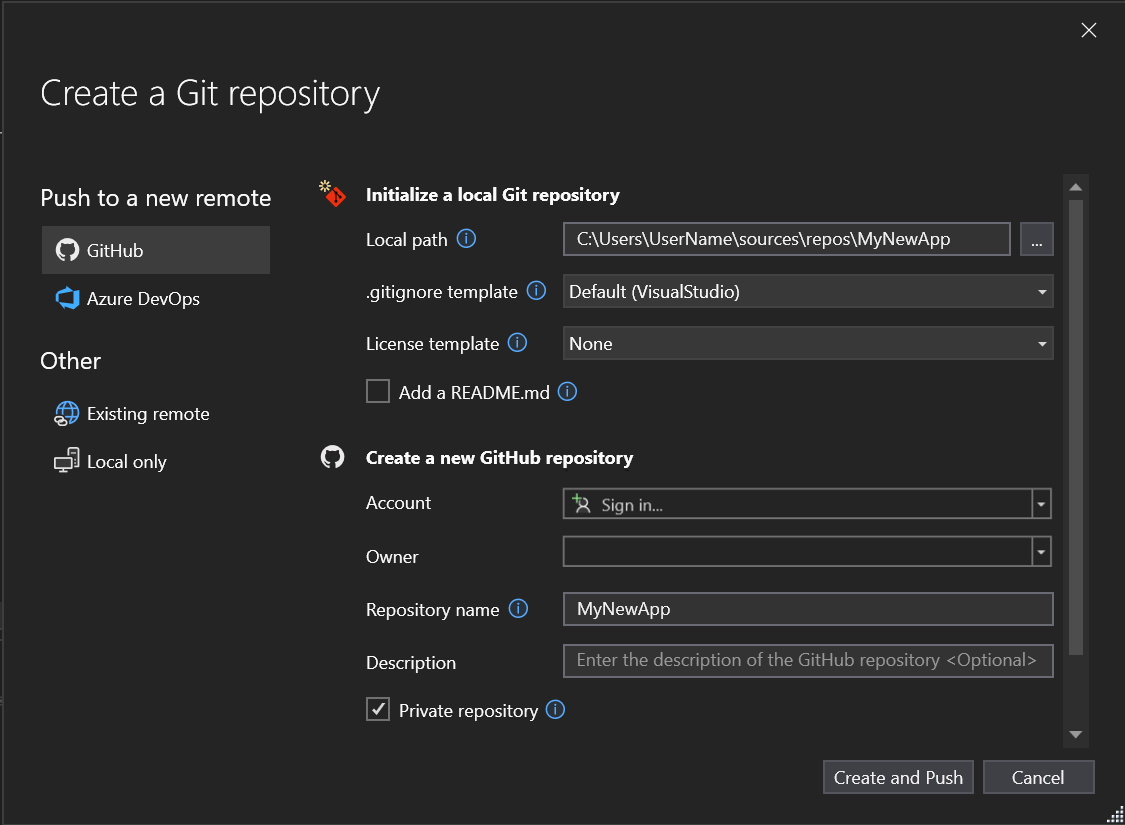
The repository name autopopulates based on your folder location. Your new repository is private by default, which means you're the only one who can access it.
Tip
Whether your repository is public or private, it's best to have a remote backup of your code stored securely on GitHub. Even if you aren't working with a team, a remote repository makes your code available to you from any computer.
Select Create and Push. After you create your repository, you see status details in the status bar:

Use Git actions in Visual Studio
Here's a brief summary of Git actions available in the Visual Studio status bar:
The Up/Down arrows show how many outgoing/incoming commits are in your current branch. You can use this icon to pull any incoming commits or push any outgoing commits.
To view a specific commit, select the Up/Down arrow, and then select View Outgoing/Incoming.
The Pencil shows the number of uncommitted changes to your code. You can select this icon to view those changes in the Git Changes window.
The Git menu provides tools for repository actions on your files. You can use git fetch, pull, push, and sync for version control in Visual Studio.
To learn more about how to use Git with your app, see the Visual Studio version control documentation.
Review: Code complete
In this tutorial, you made many changes to the Calculator app. The app now handles computing resources more efficiently, and handles most user input errors.
Here's the complete code, all in one place:
class Calculator
{
public static double DoOperation(double num1, double num2, string op)
{
double result = double.NaN; // Default value is "not-a-number" which we use if an operation, such as division, could result in an error.
// Use a switch statement to do the math.
switch (op)
{
case "a":
result = num1 + num2;
break;
case "s":
result = num1 - num2;
break;
case "m":
result = num1 * num2;
break;
case "d":
// Ask the user to enter a non-zero divisor.
if (num2 != 0)
{
result = num1 / num2;
}
break;
// Return text for an incorrect option entry.
default:
break;
}
return result;
}
}
class Program
{
static void Main(string[] args)
{
bool endApp = false;
// Display title as the C# console calculator app.
Console.WriteLine("Console Calculator in C#\r");
Console.WriteLine("------------------------\n");
while (!endApp)
{
// Declare variables and set to empty.
string numInput1 = "";
string numInput2 = "";
double result = 0;
// Ask the user to type the first number.
Console.Write("Type a number, and then press Enter: ");
numInput1 = Console.ReadLine();
double cleanNum1 = 0;
while (!double.TryParse(numInput1, out cleanNum1))
{
Console.Write("This is not valid input. Please enter a numeric value: ");
numInput1 = Console.ReadLine();
}
// Ask the user to type the second number.
Console.Write("Type another number, and then press Enter: ");
numInput2 = Console.ReadLine();
double cleanNum2 = 0;
while (!double.TryParse(numInput2, out cleanNum2))
{
Console.Write("This is not valid input. Please enter a numeric value: ");
numInput2 = Console.ReadLine();
}
// Ask the user to choose an operator.
Console.WriteLine("Choose an operator from the following list:");
Console.WriteLine("\ta - Add");
Console.WriteLine("\ts - Subtract");
Console.WriteLine("\tm - Multiply");
Console.WriteLine("\td - Divide");
Console.Write("Your option? ");
string op = Console.ReadLine();
try
{
result = Calculator.DoOperation(cleanNum1, cleanNum2, op);
if (double.IsNaN(result))
{
Console.WriteLine("This operation will result in a mathematical error.\n");
}
else Console.WriteLine("Your result: {0:0.##}\n", result);
}
catch (Exception e)
{
Console.WriteLine("Oh no! An exception occurred trying to do the math.\n - Details: " + e.Message);
}
Console.WriteLine("------------------------\n");
// Wait for the user to respond before closing.
Console.Write("Press 'n' and Enter to close the app, or press any other key and Enter to continue: ");
if (Console.ReadLine() == "n") endApp = true;
Console.WriteLine("\n"); // Friendly linespacing.
}
return;
}
}
class Calculator
{
public static double DoOperation(double num1, double num2, string op)
{
double result = double.NaN; // Default value is "not-a-number" which we use if an operation, such as division, could result in an error.
// Use a switch statement to do the math.
switch (op)
{
case "a":
result = num1 + num2;
break;
case "s":
result = num1 - num2;
break;
case "m":
result = num1 * num2;
break;
case "d":
// Ask the user to enter a non-zero divisor.
if (num2 != 0)
{
result = num1 / num2;
}
break;
// Return text for an incorrect option entry.
default:
break;
}
return result;
}
}
class Program
{
static void Main(string[] args)
{
bool endApp = false;
// Display title as the C# console calculator app.
Console.WriteLine("Console Calculator in C#\r");
Console.WriteLine("------------------------\n");
while (!endApp)
{
// Declare variables and set to empty.
// Use Nullable types (with ?) to match type of System.Console.ReadLine
string? numInput1 = "";
string? numInput2 = "";
double result = 0;
// Ask the user to type the first number.
Console.Write("Type a number, and then press Enter: ");
numInput1 = Console.ReadLine();
double cleanNum1 = 0;
while (!double.TryParse(numInput1, out cleanNum1))
{
Console.Write("This is not valid input. Please enter a numeric value: ");
numInput1 = Console.ReadLine();
}
// Ask the user to type the second number.
Console.Write("Type another number, and then press Enter: ");
numInput2 = Console.ReadLine();
double cleanNum2 = 0;
while (!double.TryParse(numInput2, out cleanNum2))
{
Console.Write("This is not valid input. Please enter a numeric value: ");
numInput2 = Console.ReadLine();
}
// Ask the user to choose an operator.
Console.WriteLine("Choose an operator from the following list:");
Console.WriteLine("\ta - Add");
Console.WriteLine("\ts - Subtract");
Console.WriteLine("\tm - Multiply");
Console.WriteLine("\td - Divide");
Console.Write("Your option? ");
string? op = Console.ReadLine();
// Validate input is not null, and matches the pattern
if (op == null || ! Regex.IsMatch(op, "[a|s|m|d]"))
{
Console.WriteLine("Error: Unrecognized input.");
}
else
{
try
{
result = calculator.DoOperation(cleanNum1, cleanNum2, op);
if (double.IsNaN(result))
{
Console.WriteLine("This operation will result in a mathematical error.\n");
}
else Console.WriteLine("Your result: {0:0.##}\n", result);
}
catch (Exception e)
{
Console.WriteLine("Oh no! An exception occurred trying to do the math.\n - Details: " + e.Message);
}
}
Console.WriteLine("------------------------\n");
// Wait for the user to respond before closing.
Console.Write("Press 'n' and Enter to close the app, or press any other key and Enter to continue: ");
if (Console.ReadLine() == "n") endApp = true;
Console.WriteLine("\n"); // Friendly linespacing.
}
return;
}
}
Next steps
Continue with the second part of this tutorial:
Feedback
Coming soon: Throughout 2024 we will be phasing out GitHub Issues as the feedback mechanism for content and replacing it with a new feedback system. For more information see: https://aka.ms/ContentUserFeedback.
Submit and view feedback for
